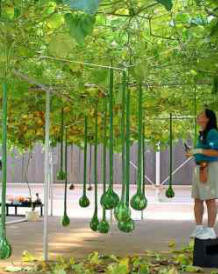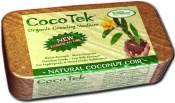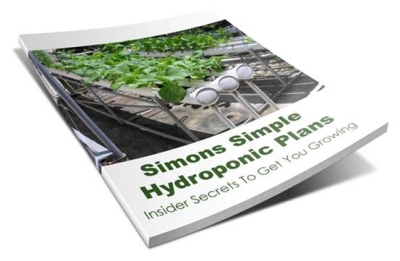The Urban Farmer, Issue #025 * Vertical Farming * Coco Coir * Kits ‘N Tips
June,
2010:

“There are no gardening
mistakes, only experiments.”
~ Janet Kilburn Phillips
VERTICAL FARMING: SOLUTION FOR THE
FUTURE?
Vertical hydroponic farming may be just the solution for feeding the
masses who reside in urban areas. A vertical farm growing hydroponically would
be much more productive and conserving of water than traditional farming
methods. Highrise buildings would be ideal for futuristic hydro farms, and
would provide fresh and nutritious produce right inside the urban borders.
Though a farm of this type would require energy and power for the lights inside
it, solar heat could be integrated into the building design so the farm could
generate much of its own power. Because vegetables and fruits would not need to
be trucked in from hundreds of miles away, the farm would lessen the
environmental impact on the earth.
Vertical farms would also offer employment
opportunities to city residents. Soon, one need not live in Iowa to farm!
Urban dwellers could go to work in shifts, just as they would for other factory
and farming jobs, only their farm will be in a building that looks similar to a
bank or a stock exchange! Vertical hydroponics take the guesswork out of
farming, eliminating crop failures due to weather. Produce would also be
available year-round, without expense of shipping it from far corners of the
globe.
The website
http://www.verticalfarm.com is the industry leading website for
information about vertical farming. Vertical farms are large hydroponics farms
within buildings that are several stories tall. With over 60% of the world’s
population living in and around urban centers, far from farming areas and
without space to grow food, vertical farms are likely the future of commercial
agriculture. Vertical farms can produce food tenfold over the same space using
traditional agricultural methods. As prices of fuel increase, and population
growth increases, vertical farms will provide much needed, affordable,
nutritious food to city citizens.
For information on another type of vertical
gardening, something you can do in your own back yard, visit:
http://www.vertigro.com/.

WHAT IS COCO COIR?
Eco Friendly CoCo Coir!
CoCo Coir is the ‘coir fiber pith’ or ‘coir dust’ produced as a bi-product when
coconut husks are processed for the extraction of the long fibers from the husk.
The fibers are used to manufacture many products, such as fibrous floor mats.
CoCo Coir is consistent and uniform in texture. It is a completely homogenous
material composed of millions of capillary micro-sponges, that absorb and hold
up to eight times it’s own weight in water. The natural pH of 5.7 to 6.5, plus
it’s ability to hold fluid assures that coir will hold and release nutrients in
solution over extended periods without rewatering.
Healthy root growth is proven with this soilless medium. The Hydroponic industry
has observed that plants grown in coir develop larger roots, stems and blooms.
This is because unlike ordinary soil, which is usually compacted, CoCo Coir
provides more breathing space and aeration for plant roots, supplying essential
oxygen, resulting in better growth. CoCo Coir Peat has a naturally high lignin
content which encourages favorable micro-organisms around the root zone. Having
a slow degradation rate, it promotes an optimum pH level.
For more about this excellent hydroponics medium and where to order, visit:
http://www.hydroponics-simplified.com/coco-coir.html.
SALES ARE BRISK!

We are very encouraged by initial sales of our new hydroponics products. We are
proud of the hard work we put in to produce these quality resources for your
hydroponics adventures:
- Make a PVC hydroponics stand (kit)
- Build a sturdy, turbo-cooled grow closet (ebook
and/or kit)
- Ebook: Plans for all 4 full-sized hydro
gardens in one book! (ebb & flow, top drip, raft and wick), PLUS the PVC
stand, with many great
bonuses
Check ’em out:
U-Build-It
Hydro Tip of the Month
Having problems in your garden? Zip through these
easy climate fixes before going any further:
Climate
- Is the temperature between 60-90°? Is there a 10° drop when the lights
go out for the night?
- Is the RH (relative humidity) between 50-70%? (50-60% is best)
- Ventilation: Do you have adequate air exchange, or is it stagnant and
stale in there? Is the stale air being vented out somehow? Do you have a fan
gently stirring the leaves 24/7?
We hope you have enjoyed this issue of The Urban Farmer Ezine. Each month, we will bring you another inspiring photo, gardening quote or idea, plus fresh new hydroponics news, techniques & products.
Insiders tips to get you growing…

~Stella and Simon from
Hydroponics-Simplified.
|


Reply